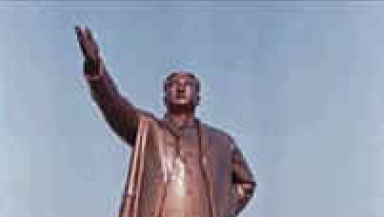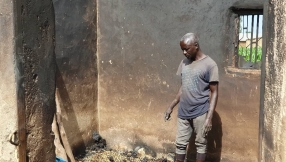North Korea is once again making headlines due to the unsettling behaviour of its erratic tyrant, Kim Jong-un, whose family dynasty has made it the world's most inhospitable place towards religion. A particular animosity is reserved for Christians.
Ironically, what is now the North Korean capital city of Pyongyang was – a century earlier – such a hotbed of Christian activity that it was known as the 'Jerusalem of the East'. Though Christians remained a small minority of the overall North Korean population, Pyongyang was a different story, and at its high point, three out of 10 people there were practising Christians. More than 2,000 and possibly as many as 3,000 churches were built in the region. 'Crosses dotted the Pyongyang skyline' and downtown street preachers would shout, 'Believe in Jesus and go to heaven', as Hyun Sook Foley says in his article, 'The Jerusalem of the East', in Christian History magazine.
Catholicism arrived in Korea in the late 1700s, largely by way of native-born scholars and traders who'd encountered the faith during their international travels. Koreans had been more receptive to Christianity than people in most other parts of Asia and enough converts were made that it began to be viewed by the establishment as a threat. Starting in the early years of the 1800s, Catholics (some foreign priests, but most of them Korean converts) were murdered. Even under formidable and often dangerous opposition, both Catholicism and Protestantism spread effectively in Korea.
An 1882 treaty between Korea and the United States launched diplomatic relations between the two nations. From this point, American missionaries (mostly Protestant) flocked to the region, where they established roots by building hospitals and schools, such as Union Christian College (which now exists as Soongsil University in Seoul, South Korea) and the Pyongyang Theological Seminary (which now exists as Chongshin University, also in Seoul).
The closing years of the 1800s and the opening years of the 1900s saw the fastest growth in Pyongyang's Christianity. In January 1907, a meeting between Western missionaries and North Korean Christians resulted in a prolonged outpouring of religious sentiment and church construction known as the Pyongyang Revival.
The year 1910 saw the beginning of a Japanese occupation of Korea that lasted until 1945. The Japanese occupiers were very hostile towards Christians, many of whom were incarcerated, and some of whom were martyred. But the faith, and most of the churches, endured. Though many North Koreans turned to Communism, there was not so much friction initially between the North Korean Christians and Communists because both were oppressed by the occupying Japanese.

During World War II, there were more than three times as many Christians in North Korea as in South Korea, according to Jin-Heon Jung's article 'Underground Railroads of Christian Conversion: North Korean Migrants and Evangelical Missionary Networks in Northeast Asia' for the journal Cultural Diversity in China. However, the end of WWII saw a mass migration of Christians from North to South Korea. Even following that exodus, South Korea's Christian population has since risen enormously, and now accounts for almost 30 per cent of its total populace.
In post-WWII North Korea, the government went after churches by seizing the bank accounts of Christians. By then, there was basically no freedom of the press in North Korea. Soon after the euphemistically-named Democratic People's Republic of Korea was established on September 9, 1948, authorities began arresting people attending religious services and raiding Christian homes to confiscate any religious materials.
Since 1948, Kim Il-sung, the first leader in North Korea's dynasty of murder and tyranny, has been (often forcibly) worshipped as God in his homeland. His mother, though, might have objected: she was a Presbyterian deaconess. His father also had been an ardent Christian. And North Korea's supreme leader himself, who so vigorously expunged Christianity from his nation, had once been a church organist. As he came to power, though, he saw that deities would be an obstacle to his exalted status. It was Kim or God, and one of them had to go.
Upon making his decision, the first Kim incarcerated Christians on a massive scale. He also portrayed the faith as a reviled tool of American imperialism and 'spread rumors that missionaries were Western spies who branded Korean children with hot irons and sold their blood', as told by Victor Cha in his book The Impossible State: North Korea, Past and Future. During the Korean War (1950-1953), Kim Il-sung ordered the murders of many thousands of Christians. By 1960, there were zero houses of worship in North Korea.
These days, there are four state-sanctioned 'churches' in Pyongyang (two Protestant, one Roman Catholic, and one Russian Orthodox). They exist as 'proof' that North Korea tolerates religion. Foreigners who visit them are not permitted to interact with any North Koreans in attendance. One group of visiting Christians went to a church on Easter Sunday only to find that the doors were locked. The issue was that these visitors had neglected to tell their chaperone about their Easter Sunday plans. So the chaperone was unable to arrange a staged church experience, complete with fake North Korean churchgoers, a fake religious ceremony, and, of course, unlocked church doors.
According to World Watch Monitor, tens of thousands of Christians are currently in North Korean labour camps, where they are singled out for the harshest and most humiliating treatment, as well as the most brutal methods of execution. For 15 consecutive years, Open Doors has ranked North Korea as the most oppressive nation for Christians. All of them must hide their faith from the public, and some must hide their faith even from immediate family members, who might turn in any such worshippers. Despite these circumstances, it has been estimated that as many as 300,000 Christians live in North Korea, which has an overall population of about 25.4 million.
To put it mildly, Pyongyang is a Jerusalem no more. But much as the Kim regime has endeavoured to banish God, many thousands of North Koreans have continued to embrace him – in secret and at tremendous personal risk.













